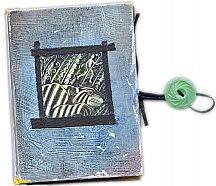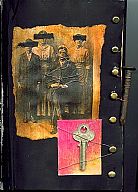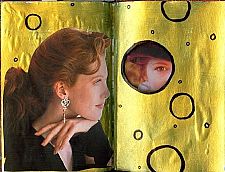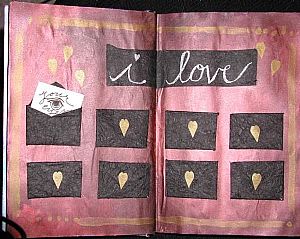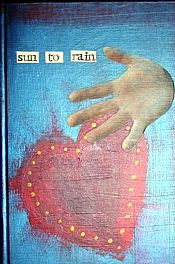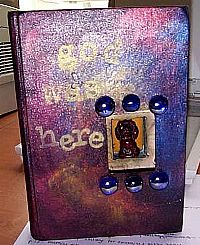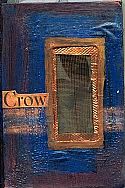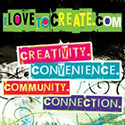From Art Journaling II I share with you their post...
Beginning
Just to let
you all know, I have no end point in sight for our journaling adventure
together, I don’t want to be in a rush but I also don’t want to drag my feet,
either.
I trust that you guys will let me know if I’m going to slow or too fast, if I'm including too much or not enough. I just want your place here, and this is your place, to be somewhere you come to let go and really immerse yourself in a true learning and growing experience.
The real first steps have mainly been covered when you found your journal and gathered your basic supplies. You will find yourself wanting to expand your supply base as you continue to art journal but begin with some of the simple supplies we discussed earlier.
Now it’s time to find a comfortable place to work. A place where you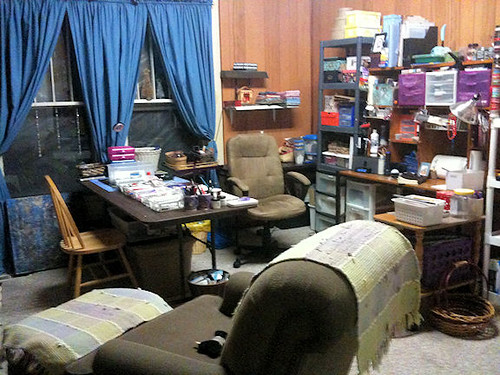 can spread your supplies out, get messy and not have to worry about
little hands (if you have them around) getting into anything.
can spread your supplies out, get messy and not have to worry about
little hands (if you have them around) getting into anything.
It can be the kitchen table, the coffee table, in your craft room or art studio, it can be on a TV tray with your journaling supplies in a box beside you. It just has to be anywhere you feel comfy.
Now that you’re all settled in, let’s do this…
Everyone has to start somewhere and the blank page is where it all begins. For every single one of us. I remember the feeling of terror that would wash over me in the beginning when I was faced with the blank page. I beg of you…don’t do that to yourself. It is just paper. Nothing but paper.
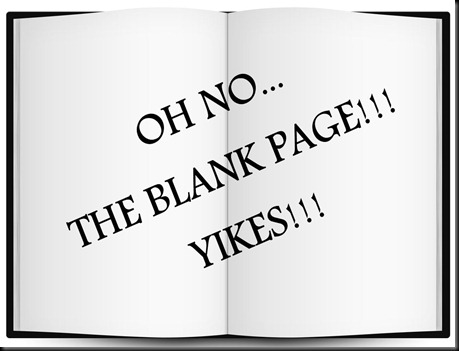
The first step for most art journalists is page prep. Think about these things: are your pages thick enough? Do you need/want to *gesso? What the heck is this gesso she keeps mentioning? Altering a book and need to glue pages together? Using thin lined pages that need some extra umph? Just be sure to take care of any of these issues before you move on.
Next step is the background and most of the time, the first step to that is adding color. So, let’s begin by putting some color down on that dreaded blank page…get it over with…you can add color in any way you want. If you have tons of scrapbook paper and want to use some of it as your color base, go for it. Glue it down. Collage different colors and make your page exactly what you want it to be. Don’t be afraid of making a mistake.
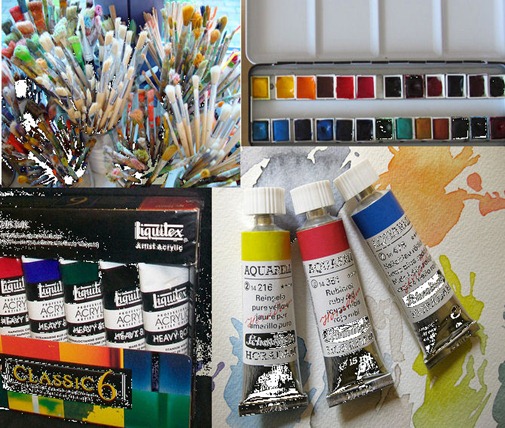 Maybe you’re a marker
person, by all means, use them to make your pages bright and colorful (or dark
and mysterious...go with how you feel.) Or pick 1, 2 or even 3 colors of your
craft paint, acrylic paint or break out your watercolors and spread beautiful,
wonderful, fabulous color onto your page.
Maybe you’re a marker
person, by all means, use them to make your pages bright and colorful (or dark
and mysterious...go with how you feel.) Or pick 1, 2 or even 3 colors of your
craft paint, acrylic paint or break out your watercolors and spread beautiful,
wonderful, fabulous color onto your page.
There are so many ways to get the paint onto the page. Of course you can use a brush or, if you’re using craft/acrylic paints, spread them around and cover the page using an old credit card or room key card to scrape the paint onto the page. You can use your fingers to spread it around or a sponge to dab and smoosh it all over the page.
Use some colorful inks and drip them onto the page so they splatter everywhere. Make your colors calm and evenly painted or grungy, scrubbed in and messy…it is your journal so it is your choice.
Here are two different pages of mine, one calm and the other a little grungy (I love both!)
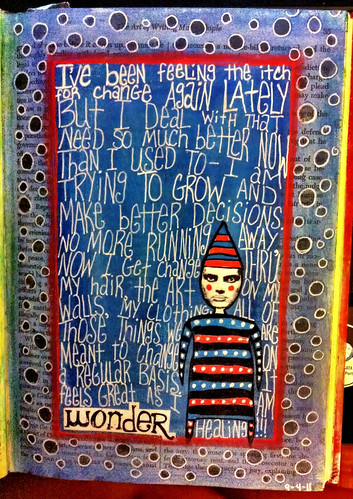
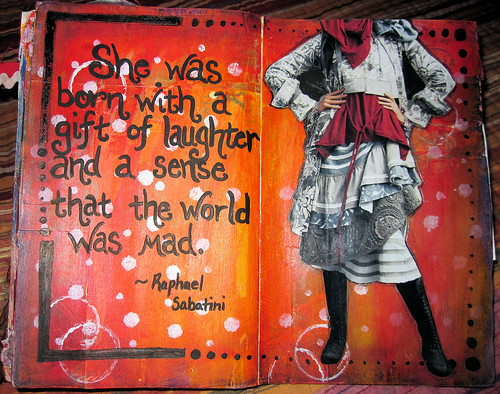
What other ways can you think of to add color or basically get your blank page from white (or tan) to a point that you’re not so afraid of it anymore…to a point that the colors excite you and make you want to experiment? Colorful in a way that speaks to you and makes you want to tell your story or reminds you of a quote or song lyric that means something to you. Maybe the colors make you think of that day at the beach or the mountains or in the rain.
A few words of caution…if you plan on writing in a particular place, I would caution you not to use any wax based colors such as watercolor crayons, water soluble oil pastels and even most colored pencils. These can be hard to write over with most pens and will even clog up sharpie permanent markers and, my favorite, Sharpie Paint Pens. Just be aware of that when adding color to your pages. (There are ways around this and we will get to that down the road a bit.)
I love art journaling and realize that when I found it back in 2007, I really found my passion. I have learned not to take things so seriously between the pages of my journals. There really is no such thing as a mistake…just something else to work into that page.
Please don’t let your art journal be a burden or another something to add more stress to your life. Let it be the place that you can come to and unburden your soul, your mind, your energy.
When choosing your colors notice that the colors you choose can speak as to your mood and your inner feelings. I have often noticed that I use reds when I am angry, blues and greens when I’m calm and peaceful, blacks and browns if I am down and depressed, yellows when I’m cheerful or happy.
Last note, I hope that you won’t just do one background of color and stop, waiting on our next step…put a color layer of your choice on a few pages or more. Have fun experimenting with color combinations or different mediums…acrylic one page then watercolor on the next then go ahead and try gluing some great papers down on the next page.
For goodness sake, have fun playing. Remember what it was like to be a kid. Just relax and have a good time in YOUR journal.
I trust that you guys will let me know if I’m going to slow or too fast, if I'm including too much or not enough. I just want your place here, and this is your place, to be somewhere you come to let go and really immerse yourself in a true learning and growing experience.
The real first steps have mainly been covered when you found your journal and gathered your basic supplies. You will find yourself wanting to expand your supply base as you continue to art journal but begin with some of the simple supplies we discussed earlier.
Now it’s time to find a comfortable place to work. A place where you
 can spread your supplies out, get messy and not have to worry about
little hands (if you have them around) getting into anything.
can spread your supplies out, get messy and not have to worry about
little hands (if you have them around) getting into anything. It can be the kitchen table, the coffee table, in your craft room or art studio, it can be on a TV tray with your journaling supplies in a box beside you. It just has to be anywhere you feel comfy.
Now that you’re all settled in, let’s do this…
Everyone has to start somewhere and the blank page is where it all begins. For every single one of us. I remember the feeling of terror that would wash over me in the beginning when I was faced with the blank page. I beg of you…don’t do that to yourself. It is just paper. Nothing but paper.

The first step for most art journalists is page prep. Think about these things: are your pages thick enough? Do you need/want to *gesso? What the heck is this gesso she keeps mentioning? Altering a book and need to glue pages together? Using thin lined pages that need some extra umph? Just be sure to take care of any of these issues before you move on.
Next step is the background and most of the time, the first step to that is adding color. So, let’s begin by putting some color down on that dreaded blank page…get it over with…you can add color in any way you want. If you have tons of scrapbook paper and want to use some of it as your color base, go for it. Glue it down. Collage different colors and make your page exactly what you want it to be. Don’t be afraid of making a mistake.
 Maybe you’re a marker
person, by all means, use them to make your pages bright and colorful (or dark
and mysterious...go with how you feel.) Or pick 1, 2 or even 3 colors of your
craft paint, acrylic paint or break out your watercolors and spread beautiful,
wonderful, fabulous color onto your page.
Maybe you’re a marker
person, by all means, use them to make your pages bright and colorful (or dark
and mysterious...go with how you feel.) Or pick 1, 2 or even 3 colors of your
craft paint, acrylic paint or break out your watercolors and spread beautiful,
wonderful, fabulous color onto your page.There are so many ways to get the paint onto the page. Of course you can use a brush or, if you’re using craft/acrylic paints, spread them around and cover the page using an old credit card or room key card to scrape the paint onto the page. You can use your fingers to spread it around or a sponge to dab and smoosh it all over the page.
Use some colorful inks and drip them onto the page so they splatter everywhere. Make your colors calm and evenly painted or grungy, scrubbed in and messy…it is your journal so it is your choice.
Here are two different pages of mine, one calm and the other a little grungy (I love both!)


What other ways can you think of to add color or basically get your blank page from white (or tan) to a point that you’re not so afraid of it anymore…to a point that the colors excite you and make you want to experiment? Colorful in a way that speaks to you and makes you want to tell your story or reminds you of a quote or song lyric that means something to you. Maybe the colors make you think of that day at the beach or the mountains or in the rain.
A few words of caution…if you plan on writing in a particular place, I would caution you not to use any wax based colors such as watercolor crayons, water soluble oil pastels and even most colored pencils. These can be hard to write over with most pens and will even clog up sharpie permanent markers and, my favorite, Sharpie Paint Pens. Just be aware of that when adding color to your pages. (There are ways around this and we will get to that down the road a bit.)
I love art journaling and realize that when I found it back in 2007, I really found my passion. I have learned not to take things so seriously between the pages of my journals. There really is no such thing as a mistake…just something else to work into that page.
Please don’t let your art journal be a burden or another something to add more stress to your life. Let it be the place that you can come to and unburden your soul, your mind, your energy.
When choosing your colors notice that the colors you choose can speak as to your mood and your inner feelings. I have often noticed that I use reds when I am angry, blues and greens when I’m calm and peaceful, blacks and browns if I am down and depressed, yellows when I’m cheerful or happy.
Last note, I hope that you won’t just do one background of color and stop, waiting on our next step…put a color layer of your choice on a few pages or more. Have fun experimenting with color combinations or different mediums…acrylic one page then watercolor on the next then go ahead and try gluing some great papers down on the next page.
For goodness sake, have fun playing. Remember what it was like to be a kid. Just relax and have a good time in YOUR journal.

 Posted by
Posted by
